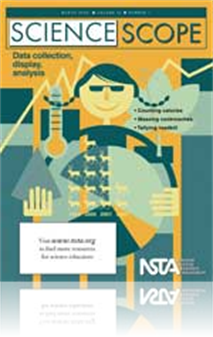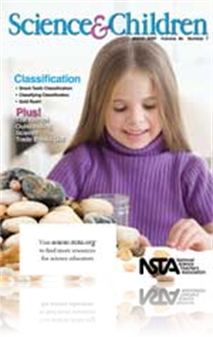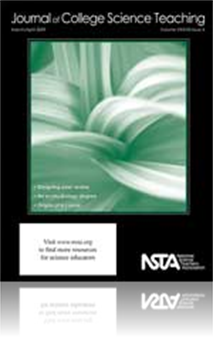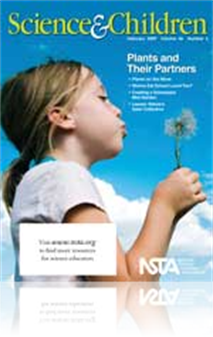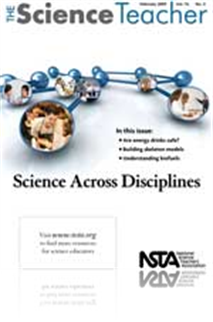All Resources
Journal Article
Teacher’s Toolkit: Cracking the method
One problem we face as teachers of sixth-grade science is how to teach the process of inquiry to students who are still used to learning everything concretely. Indeed, even after walking students through an inquiry lab while modeling the lab-report-w...
Journal Article
What About Albert Einstein? Using Biographies to Promote Students’ Scientific Thinking
Who hasn’t heard of Einstein? Science educators everywhere are familiar with Einstein’s genius and general theory of relativity. Students easily recognize Einstein’s image by his white flyaway hair and bushy mustache. It is well known that Eins...
Journal Article
An after-school science class on properties teaches students “all that glitters is not gold.” Through this gold panning simulation, students analyze the properties of pyrite, or “Fool’s Gold,” and discover the importance of properties to e...
Journal Article
Methods and Strategies: The Home Connection
Teachers can help students gain experience in the natural world by taking students outside, but such experiences usually have tight time constraints due to elementary students’ very busy daily school schedules. Another important, yet often overlook...
Journal Article
Outstanding Science Trade Books for Students K–12 (Books published in 2008)
Today’s classrooms have no real walls! Students explore the world on field trips, during virtual journeys on the world wide web, and through the books they read. These pathways help them fly to the ends of the universe to satisfy their scientific c...
Journal Article
Editor’s Roundtable: Essential data
Answering a question or proposing an explanation based on evidence gathered from observations and measurements is at the heart of scientific inquiry. To develop this ability, teachers should provide repeated opportunities for students to generate que...
Journal Article
Science 101: What makes a curveball curve?
Ah, springtime, and young people’s thoughts turn to … baseball, of course. But this column is not about how to throw a curveball, so you’ll have to look that up on your own. Here the focus is on the why of the curveball. There are two different...
Journal Article
MathBench Biology Modules: Web-Based Math for All Biology Undergraduates
Historically, biology has not been a heavily quantitative science, but this is changing rapidly (Ewing 2002; Gross 2000; Hastings and palmer 2003; Jungck 2005; Steen 2005). Quantitative approaches now constitute a key tool for modern biologists, yet ...
Journal Article
Tired and True: Message in a bottle—Analyzing reaction rates using gas pressure sensors
One of the many ways to engage students in science is by using probes or computerized devices that respond in real time to changes. In the following learning cycle lesson, an after-school science and mathematics club consisting of about 20 students u...
Journal Article
Science Sampler: Laws of motion
What do you get when you cross an electronic whiteboard, online videos, and a room full of sixth graders? This may perhaps sound like an uncontrollable mix, but these simple ingredients create an interesting way to reinforce student understanding of ...
Journal Article
On Clickers, Questions, and Learning
The purpose of this paper is to review the procedures used to help students become learning victors. Specifically, this paper will discuss the process used to integrate classroom-response-system technology and question-driven instruction into an intr...
Journal Article
Science Sampler: Making connections in Earth science using local data
Examining data provides a unique opportunity to have students work actively with various technologies, such as computers or graphing calculators. Students can import data into spreadsheet software, execute mathematical calculations, create data graph...
Journal Article
Research and Teaching: Team-Based Learning Enhances Performance in Introductory Biology
Given the problems associated with the traditional lecture method, the constraints associated with large classes, and the effectiveness of active learning, continued development and testing of efficient student-centered learning approaches are needed...
Journal Article
Chow Down! Using Madagascar Hissing Cockroaches to Explore Basic Nutrition Concepts
The Madagascar hissing cockroach gromphadorhina portentosa) is one of the most exciting and enjoyable animals to incorporate into your science curriculum. Madagascar hissing cockroaches (MHCs) do not bite, are easy to handle, produce little odor comp...
Journal Article
Editorial: <em>Au Courant</em> Connections
In an effort to connect with college-level science instructors “beyond the classroom walls,” the editor plans to start a blog. Blogs are the electronic equivalent of an open conversation at a relaxed conference. You get there through an internet ...
Book Chapter
The Role of Leadership in Fostering Inquiry-Based Learning and Teaching
In this chapter, the author first address the concepts of inquiry and leadership presented in the National Science Education Standards (NRC 1996). Then presents examples of leaders who foster inquiry-based learning and teaching within the context o...
Book Chapter
Bending the Professional Teaching Continuum: How Teacher Renewal Supports Teacher Retention
This chapter is built on the premise that science teachers develop their practice along a professional continuum that consists of recruitment, preparation, new teacher induction, ongoing professional development, and advanced certification or master ...
Book Chapter
No Boundaries: The Role of Mobility in Recruiting New Teachers and Developing New Leaders
The development of teacher leaders in any discipline is hindered when the pool of available candidates is shallow, and developing science leaders—whether at the classroom, district, state, or national level—largely depends on having a rich and ro...
Book Chapter
Professional Learning Communities: School Collaboration in Implement Science Education Reform
It has never been more important for teachers to work together. We must learn from each other, open up our classrooms, share student work, serve as mentors and coaches, and work with mentors and coaches. Until recently, training and professional deve...
Book Chapter
This chapter addresses how to create a community of minority science teacher leaders who are not only committed to teaching in urban schools, but also to helping close the achievement gap, especially in the area of science education. It also explores...
Book Chapter
Assessing Assessment to Inform Science Leadership
This chapter uses the ReaL Earth System Science project as a metaphor for investigating the landscape of assessment in science education. This framing turns the focus of the five questions away from the Earth system and toward the system of education...
Book Chapter
Care to Share? The Marymount School Science Department Professional Development Program
This chapter reveals how one school, The Marymount School of New York, developed a goal-setting model. This model effectively promotes innovation in the classroom, in the curriculum, and in the school and involves teachers in the decision-making proc...
Book Chapter
Leadership for Public Understanding of Science
Science is generally considered to be one of the most important subjects in the school curriculum, even if it does not receive as much attention as math and reading-language arts, which have always formed the central core of the elementary school cur...
Book Chapter
Science Communication and Public Engagement With Science
It is the responsibility of all who have a passion for science and science education to serve as ambassadors of science because we need as many great communicators of science as possible. The first section of this chapter provides useful tips for edu...
Book Chapter
The Many Faces of Leadership in a Complex Environment
While the full implementation of the leadership approach recommended in this chapter has many facets, the foundation of that leadership style is to “keep you eye on the prize.” That is, every decision should consider at its nucleus how it will su...
Book Chapter
Content Coverage in the Role of Instructional Leadership
The variability in content coverage is likely to produce differences in student learning outcomes. The authors use this variability to reinforce their view that the management of content coverage, including association time allocation, is among the m...
Book Chapter
The Role of Teacher Leadership in Science Education
Professional development activities deepen content knowledge, support inquiry-based teaching, help teachers tap into student thinking, and assist in implementing curriculum materials and interpreting assessment systems. This chapter examines teachers...
Book Chapter
Getting Results From Science Teacher Leadership: The Critical Role of Principals
There is growing evidence that teacher leaders and principals are indeed effecting-and perhaps-essential allies in leading schoolwide improvement in teacher effectiveness and student learning. This chapter opens with a detailed look at the empirical ...
Book Chapter
Developing and Sustaining Leadership in Science Education
It can be argued that the most important guiding force leading to a teacher’s continued improvement is having a good role model, such as a colleague who is an experienced leader. This chapter provides a detailed description of a master’s degree p...
Book Chapter
Technology Leadership for the 21st Century
This chapter addresses (a) how transformational leadership in the educational community is crucial for effective and appropriate infusion of educational technology as a fundamental part of K-12 education; (b) how educational leaders can create a robu...
NSTA Press Book
Reforming Secondary Science Instruction
Science education reform can seem a daunting task to high school science teachers. So, you might ask, why should I be bothered? The answer is that today’s students simply do not have the skill sets necessary for life in our global economy. ...
Book Chapter
Change in Secondary Science Settings: A Voice From the Field
Learning science by inquiry is central to science education reforms. In today’s working world, students need skills for finding, organizing, and managing information. They also need rich skills for working with others and for communicating orally a...
Journal Article
Science Sampler: Making a leap toward concrete inferences
Scientists are always working at refining their observations to help them make that leap toward stronger inferences. Teaching students to make inferences means showing them how to take their careful observations and use them to explain natural phenom...
Journal Article
With the use of technology such as Global Positioning System (GPS) units and Google Earth for a simple-machine scavenger hunt, you will transform a standard identification activity into an exciting learning experience that motivates students, incorpo...
Journal Article
Science 101: Do plants communicate?
Oh yes. Sometimes their conversation is flowery, sometimes not. Plants with problems try to converse and get to the root of the problem, but if not, they have been known to stalk one another. This often creates a situation where one plant leaves town...
Journal Article
The Prepared Practitioner: Brain-Based Education
Brain-based is an increasingly popular buzzword in educational circles. Brain research promises to take teaching from (supposedly) mere craft knowledge to a scientifically based realm from which researchers can make broadly applicable, objective conc...



